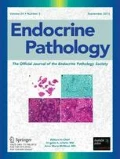Abstract
A major impediment to the development of effective treatments for metastatic or unresectable pheochromocytomas and paragangliomas has been the absence of valid models for pre-clinical testing. Attempts to establish cell lines or xenografts from human pheochromocytomas and paragangliomas have previously been unsuccessful. NOD-scid gamma (NSG) mice are a recently developed strain lacking functional B-cells, T-cells, and NK cells. We report here that xenografts of primary human paragangliomas will take in NSG mice while maintaining their architectural and immunophenotypic characteristics as expressed in the patients. In contrast to grafts of cell lines and of most common types of primary tumors, the growth rate of grafted paragangliomas is very slow, accurately representing the growth rate of most pheochromocytomas and paragangliomas even in metastases in humans. Although the model is therefore technically challenging, primary patient-derived xenografts of paragangliomas in NSG mice provide a potentially valuable new tool that could prove especially valuable for testing treatments aimed at eradicating the small tumor deposits that are often numerous in patients with metastatic paraganglioma.


Similar content being viewed by others
References
Pacak K, Wimalawansa SJ: Pheochromocytoma and paraganglioma. Endocr Pract 21:406–412, 2015
Benn DE, Robinson BG, Clifton-Bligh RJ: 15 YEARS OF PARAGANGLIOMA: Clinical manifestations of paraganglioma syndromes types 1-5. Endocr Relat Cancer 22:T91-T103, 2015
Baudin E, Habra MA, Deschamps F, et al.: Therapy of endocrine disease: treatment of malignant pheochromocytoma and paraganglioma. Eur J Endocrinol 171:R111–R122, 2014
Jansen JC, van den Berg R, Kuiper A, van der Mey AG, Zwinderman AH, Cornelisse CJ: Estimation of growth rate in patients with head and neck paragangliomas influences the treatment proposal. Cancer 88:2811–2816, 2000
Ellis RJ, Patel D, Prodanov T, Nilubol N, Pacak K, Kebebew E: The presence of SDHB mutations should modify surgical indications for carotid body paragangliomas. Ann Surg 260:158–162, 2014
Lepoutre-Lussey C, Thibault C, Buffet A, et al.: From Nf1 to Sdhb knockout: Successes and failures in the quest for animal models of pheochromocytoma. Mol Cell Endocrinol 421:40–48, 2016
Greene LA, Tischler AS: Establishment of a noradrenergic clonal line of rat adrenal pheochromocytoma cells which respond to nerve growth factor. Proc Natl Acad Sci U S A 73:2424–2428, 1976
Powers JF, Evinger MJ, Tsokas P, et al.: Pheochromocytoma cell lines from heterozygous neurofibromatosis knockout mice. Cell Tissue Res 302:309–320., 2000
Martiniova L, Lai EW, Elkahloun AG, et al.: Characterization of an animal model of aggressive metastatic pheochromocytoma linked to a specific gene signature. Clin Exp Metastasis 26:239–250, 2009
Lussey-Lepoutre C, Hollinshead KE, Ludwig C, et al.: Loss of succinate dehydrogenase activity results in dependency on pyruvate carboxylation for cellular anabolism. Nat Commun 6:8784, 2015
Tischler AS, Powers JF, Alroy J: Animal models of pheochromocytoma. Histol Histopathol 19:883–895, 2004
Shultz LD, Goodwin N, Ishikawa F, Hosur V, Lyons BL, Greiner DL: Human cancer growth and therapy in immunodeficient mouse models. Cold Spring Harb Protoc 2014:694–708, 2014
Powers JF, Picard KL, Tischler AS: RET expression and neuron-like differentiation of pheochromocytoma and normal chromaffin cells. Horm Metab Res 41:710–714, 2009
Tischler AS, Ruzicka LA, Riseberg JC: Immunocytochemical analysis of chromaffin cell proliferation in vitro. J Histochem Cytochem 40:1043–1045, 1992
Douwes Dekker PB, Corver WE, Hogendoorn PC, van der Mey AG, Cornelisse CJ: Multiparameter DNA flow-sorting demonstrates diploidy and SDHD wild-type gene retention in the sustentacular cell compartment of head and neck paragangliomas: chief cells are the only neoplastic component. J Pathol 202:456–462, 2004
Mazzatenta A, Marconi GD, Macchi V, et al.: Coexpression of Galanin and Nestin in the Chemoreceptor Cells of the Human Carotid Body. Adv Exp Med Biol 885:77–82, 2016
Rubin de Celis MF, Garcia-Martin R, Wittig D, et al.: Multipotent Glia-Like Stem Cells Mediate Stress Adaptation. Stem Cells 33:2037-2051, 2015
Oudijk L, Neuhofer CM, Lichtenauer UD, et al.: Immunohistochemical Expression of Stem Cell Markers in Pheochromocytoma/Paraganglioma is Associated with SDHx-mutations. Eur J Endocrinol 173:43-52, 2015
Hescot S, Leboulleux S, Amar L, et al.: One-year progression-free survival of therapy-naive patients with malignant pheochromocytoma and paraganglioma. J Clin Endocrinol Metab 98:4006–4012, 2013
Janssen I, Blanchet EM, Adams K, et al.: Superiority of [68Ga]-DOTATATE PET/CT to Other Functional Imaging Modalities in the Localization of SDHB-Associated Metastatic Pheochromocytoma and Paraganglioma. Clin Cancer Res 21:3888–3895, 2015
Author information
Authors and Affiliations
Corresponding author
Ethics declarations
Studies of the banked tumor samples were approved by the Institutional Review Boards of the National Institutes of Health and Tufts Medical Center. Patients provided written informed consent.
All procedures performed in studies involving animals were in accordance with the ethical standards of Tufts Medical Center.
Funding
This work was supported by the Pheo Para Alliance and by the Intramural Research Program of the National Institutes of Health and the Eunice Kennedy Shriver National Institute of Child Health and Human Development.
Conflict of Interest
The authors declare that they have no conflict of interest.
Rights and permissions
About this article
Cite this article
Powers, J.F., Pacak, K. & Tischler, A.S. Pathology of Human Pheochromocytoma and Paraganglioma Xenografts in NSG Mice. Endocr Pathol 28, 2–6 (2017). https://doi.org/10.1007/s12022-016-9452-5
Published:
Issue Date:
DOI: https://doi.org/10.1007/s12022-016-9452-5




